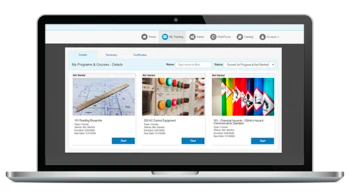Explains the effects of noncondensables on an ammonia system and the importance of their removal. Covers a wide range of piping considerations-sizing, flow rate, pressure drop, and others. Concludes with a thorough coverage of safety codes and programs, including ANSI/ASHRAE, IIAR, OSHA, and EPA information. This course has no prerequisites. Purging, Piping, and Safety is available in online maintenance training and course manual formats.
Lesson 1 - Purging Air and Noncondensables
Topics:
Materials to be purged; Effects of noncondensables; Power penalty; Purge point locations; Automatic purging; Economics of purging
Learning Objectives:
– List common noncondensable vapors and discuss their effects in a refrigeration system.
– Discuss the power penalty resulting from noncondensable gases in terms of compression and loss of refrigeration capacity.
– Explain how to determine the presence of noncondensables.
– Explain how to minimize the entrance of noncondensables and describe common entry points.
– Compare the features and operation of manual and automatic purging equipment and name the best connection points for the purge unit.
– Discuss the economic benefits of the purge unit in terms of typical payback times.
Lesson 2 - Ammonia System Piping
Topics:
Pressure drop in pipes; Laminar and turbulent flow; Line sizing, flow rate, suction line pressure drop, discharge line pressure charts; Special piping situations
Learning Objectives:
– Discuss the relationship between pressure drop requirements and pipe sizing.
– Discuss the factors that affect the pressure drop in a pipe.
– Explain the significance of the Reynolds number and the distinction between laminar and turbulent flow.
– Discuss the use of various kinds of line sizing charts including flow rate tables, equivalence tables for fittings and valves, and pressure drop charts.
– Explain how to select the proper suction line, discharge line, and liquid line sizing for an ammonia system.
– Discuss special piping situations that require alternative sizing or installation.
Lesson 3 - Ammonia System Safety Codes and Guidelines
Topics:
Codes for ammonia refrigeration systems; ANSI/ASHRAE 15-1994; ASMEB 31.5; IIAR2; IIAR bulletin 111; IIAR bulletin 112
Learning Objectives:
– Describe the basic differences between ASHRAE and ASME codes and IIAR standards and guidelines.
– Discuss several main points in the ASHRAE 15-1994 safety code for mechanical refrigeration.
– Describe code requirements based on the occupancy classifications, leak probability classifications, and refrigerant characteristic classifications.
– Describe several requirements in the ASME B 31.5 refrigeration piping code concerning the materials and fabrication of refrigeration piping systems.
– Name several safety requirements specified by IIAR 2 for ammonia refrigeration equipment.
– Describe the kinds of information provided by IIAR bulletins.
Lesson 4 - OSHA Process Safety Management
Topics:
OSHA regulations; PSM requirements; Estimation of ammonia inventory; PSM plan development; Process safety information, hazard analysis; Standard operating procedures; Contractor procedures
Learning Objectives:
– Discuss the purposes of Process Safety Management and describe the thirteen elements that make up PSM.
– Describe the process for estimating a plant's ammonia inventory and establishing a plant ammonia library and explain why each is needed.
– Discuss the personnel and steps involved in developing a PSM plan for a specific refrigeration plant.
– Describe the process hazard analysis (PHA) and explain how it can reduce the likelihood of ammonia accidents and spills.
– Describe the requirements for preparing standard operating procedures (SOPs) for all normal plant service, repair, and maintenance.
– Discuss contractor responsibilities for PSM.
– Discuss the importance of management-of-change procedures in keeping paperwork up to date.
Lesson 5 - EPA Regulations and Ammonia Safety
Topics:
40 CFR 68; Worst case/alternate ammonia release scenario; Elements in common with OSHA PSM; Penalties for nonconformance
Learning Objectives:
– Describe the purposes of the EPA Risk Management Plan and compare it to the OSHA Process Safety Management program.
– Explain the reasoning behind the dual hazard assessment requirements of a worst-case ammonia release and the more practical alternative ammonia release.
– Discuss the toxic end point criteria for an ammonia release and distinguish between rural and urban end points and differences in requirements.
– Discuss the importance and difficulties of presenting the required release data and plan to the community.
– Discuss the hazards of working with ammonia and the importance of using personal protective equipment to avoid or minimize the effects of an ammonia release.
– Describe correct first aid procedures pertaining to contact with ammonia vapor and liquid.





